KIA Optima Hybrid 2013 3.G Owner's Guide
Manufacturer: KIA, Model Year: 2013, Model line: Optima Hybrid, Model: KIA Optima Hybrid 2013 3.GPages: 394, PDF Size: 8.63 MB
Page 21 of 394

37
Safety features of your vehicle
Seatback angle
Push the control switch forward or back-
ward to move the seatback to the desired
angle. Release the switch once the seat
reaches the desired position.
Seat height (for driver’s seat)
Pull the front portion of the control switch
up to raise or down to lower the front part
of the seat cushion. Pull the rear portion
of the control switch up to raise or down
to lower the rear part of the seat cushion.
Release the switch once the seat reach-
es the desired position.
Lumbar support (for driver’s seat, if equipped)
The lumbar support can be adjusted by
pressing the lumbar support switch on
the side of the drivers seat. Press the
front portion of the switch to increase
support, or the rear portion of the switch,
to decrease support.
OTF030007OTF030008OTF030009
Page 22 of 394
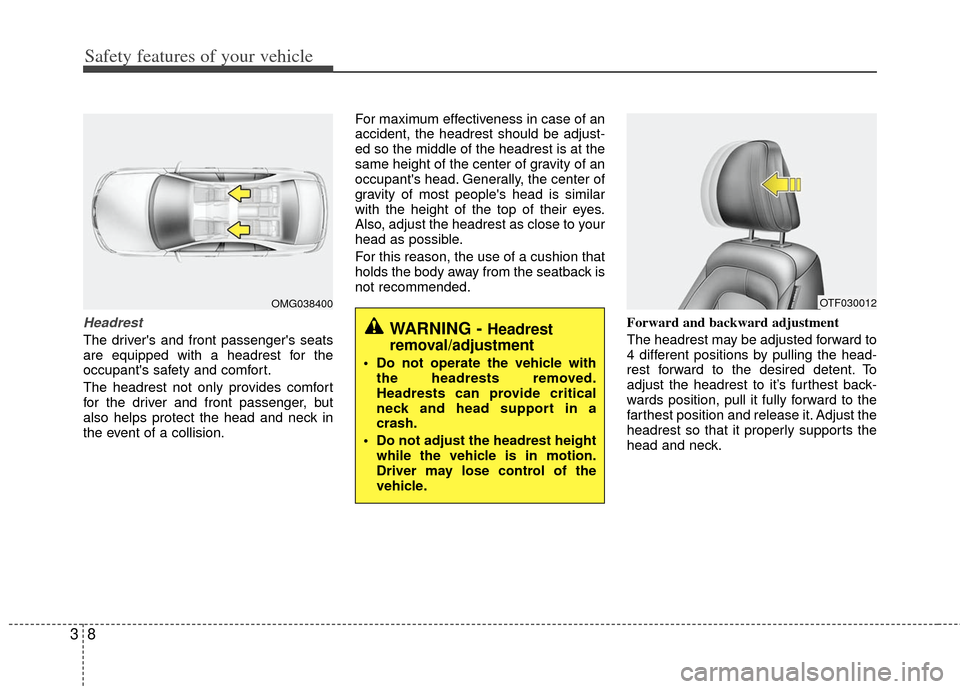
Safety features of your vehicle
83
Headrest
The driver's and front passenger's seats
are equipped with a headrest for the
occupant's safety and comfort.
The headrest not only provides comfort
for the driver and front passenger, but
also helps protect the head and neck in
the event of a collision.For maximum effectiveness in case of an
accident, the headrest should be adjust-
ed so the middle of the headrest is at the
same height of the center of gravity of an
occupant's head. Generally, the center of
gravity of most people's head is similar
with the height of the top of their eyes.
Also, adjust the headrest as close to your
head as possible.
For this reason, the use of a cushion that
holds the body away from the seatback is
not recommended.
Forward and backward adjustment
The headrest may be adjusted forward to
4 different positions by pulling the head-
rest forward to the desired detent. To
adjust the headrest to it’s furthest back-
wards position, pull it fully forward to the
farthest position and release it. Adjust the
headrest so that it properly supports the
head and neck.
OMG038400
WARNING - Headrest
removal/adjustment
Do not operate the vehicle with
the headrests removed.
Headrests can provide critical
neck and head support in a
crash.
Do not adjust the headrest height while the vehicle is in motion.
Driver may lose control of the
vehicle.
OTF030012
Page 23 of 394
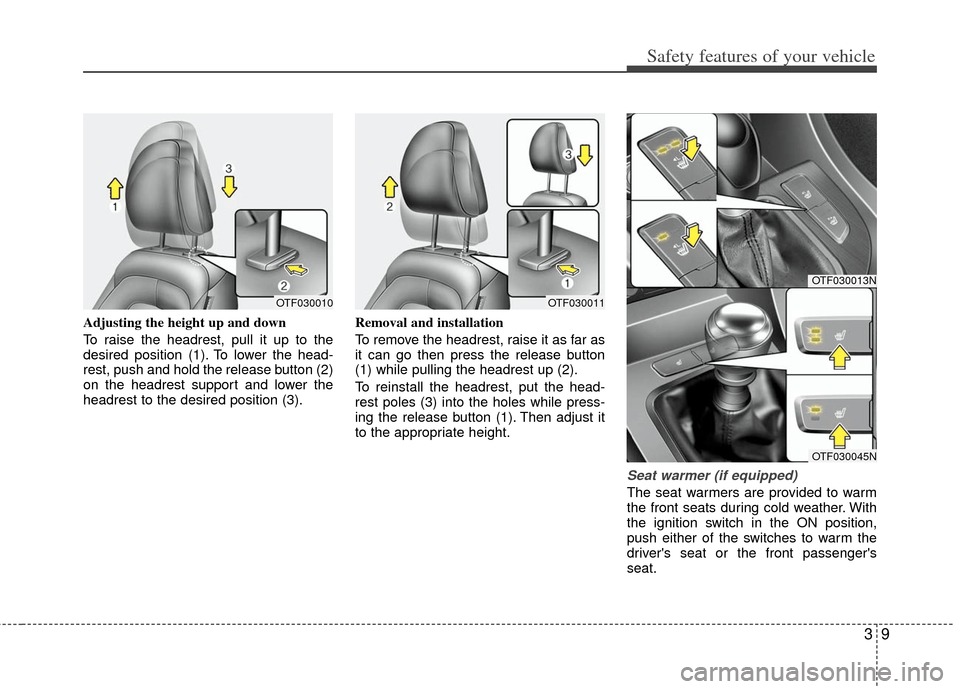
39
Safety features of your vehicle
Adjusting the height up and down
To raise the headrest, pull it up to the
desired position (1). To lower the head-
rest, push and hold the release button (2)
on the headrest support and lower the
headrest to the desired position (3).Removal and installation
To remove the headrest, raise it as far as
it can go then press the release button
(1) while pulling the headrest up (2).
To reinstall the headrest, put the head-
rest poles (3) into the holes while press-
ing the release button (1). Then adjust it
to the appropriate height.
Seat warmer (if equipped)
The seat warmers are provided to warm
the front seats during cold weather. With
the ignition switch in the ON position,
push either of the switches to warm the
driver's seat or the front passenger's
seat.
OTF030010OTF030011
OTF030013N
OTF030045N
Page 24 of 394
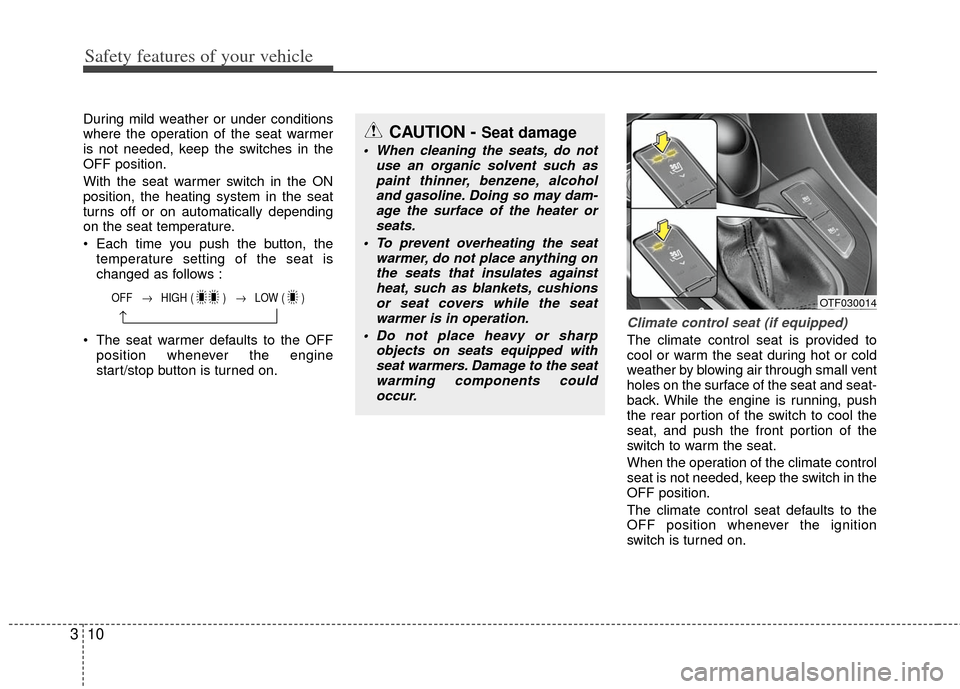
Safety features of your vehicle
10
3
During mild weather or under conditions
where the operation of the seat warmer
is not needed, keep the switches in the
OFF position.
With the seat warmer switch in the ON
position, the heating system in the seat
turns off or on automatically depending
on the seat temperature.
Each time you push the button, the
temperature setting of the seat is
changed as follows :
The seat warmer defaults to the OFF position whenever the engine
start/stop button is turned on.
Climate control seat (if equipped)
The climate control seat is provided to
cool or warm the seat during hot or cold
weather by blowing air through small vent
holes on the surface of the seat and seat-
back. While the engine is running, push
the rear portion of the switch to cool the
seat, and push the front portion of the
switch to warm the seat.
When the operation of the climate control
seat is not needed, keep the switch in the
OFF position.
The climate control seat defaults to the
OFF position whenever the ignition
switch is turned on.
CAUTION - Seat damage
When cleaning the seats, do not use an organic solvent such aspaint thinner, benzene, alcoholand gasoline. Doing so may dam-age the surface of the heater or seats.
To prevent overheating the seat warmer, do not place anything onthe seats that insulates againstheat, such as blankets, cushionsor seat covers while the seatwarmer is in operation.
Do not place heavy or sharp objects on seats equipped withseat warmers. Damage to the seatwarming components couldoccur.
OTF030014OFF → HIGH ( ) → LOW ( )
→
Page 25 of 394
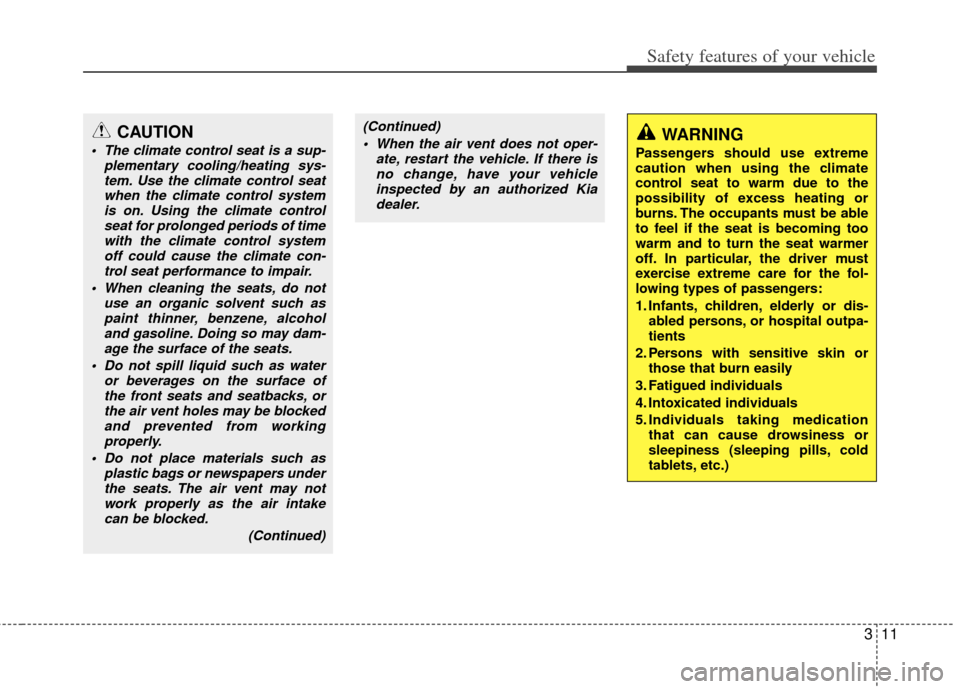
311
Safety features of your vehicle
CAUTION
The climate control seat is a sup-plementary cooling/heating sys-tem. Use the climate control seatwhen the climate control systemis on. Using the climate control seat for prolonged periods of timewith the climate control systemoff could cause the climate con-trol seat performance to impair.
When cleaning the seats, do not use an organic solvent such aspaint thinner, benzene, alcoholand gasoline. Doing so may dam-age the surface of the seats.
Do not spill liquid such as water or beverages on the surface ofthe front seats and seatbacks, orthe air vent holes may be blocked and prevented from workingproperly.
Do not place materials such as plastic bags or newspapers underthe seats. The air vent may notwork properly as the air intakecan be blocked.
(Continued)
(Continued) When the air vent does not oper- ate, restart the vehicle. If there isno change, have your vehicleinspected by an authorized Kiadealer.WARNING
Passengers should use extreme
caution when using the climate
control seat to warm due to the
possibility of excess heating or
burns. The occupants must be able
to feel if the seat is becoming too
warm and to turn the seat warmer
off. In particular, the driver must
exercise extreme care for the fol-
lowing types of passengers:
1. Infants, children, elderly or dis- abled persons, or hospital outpa-
tients
2. Persons with sensitive skin or those that burn easily
3. Fatigued individuals
4. Intoxicated individuals
5. Individuals taking medication that can cause drowsiness or
sleepiness (sleeping pills, cold
tablets, etc.)
Page 26 of 394
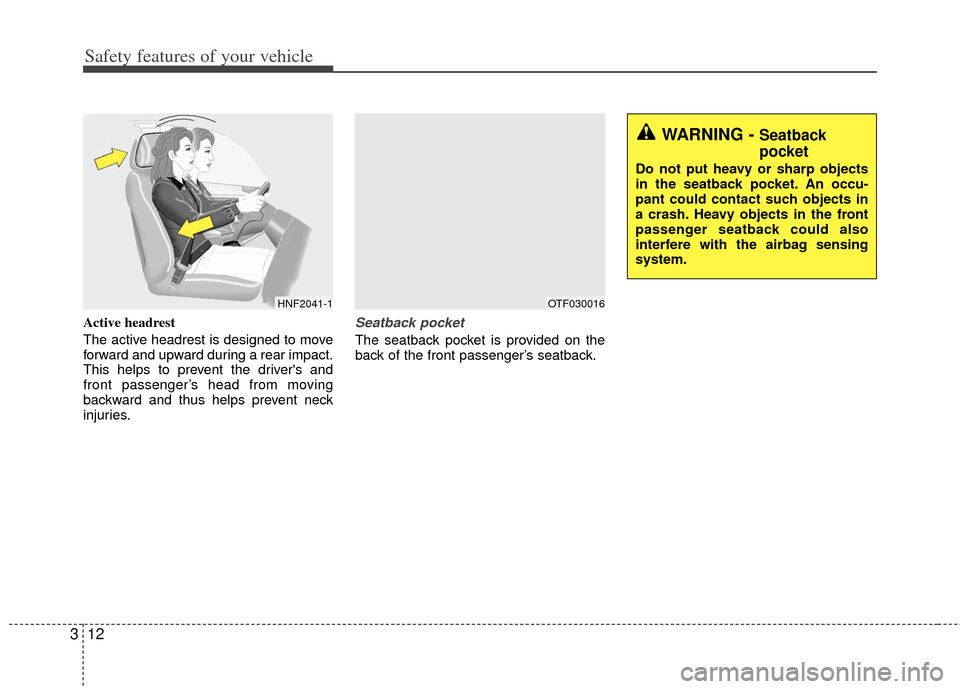
Safety features of your vehicle
12
3
Active headrest
The active headrest is designed to move
forward and upward during a rear impact.
This helps to prevent the driver's and
front passenger’s head from moving
backward and thus helps prevent neck
injuries.Seatback pocket
The seatback pocket is provided on the
back of the front passenger’s seatback.
HNF2041-1OTF030016
WARNING - Seatback
pocket
Do not put heavy or sharp objects
in the seatback pocket. An occu-
pant could contact such objects in
a crash. Heavy objects in the front
passenger seatback could also
interfere with the airbag sensing
system.
Page 27 of 394
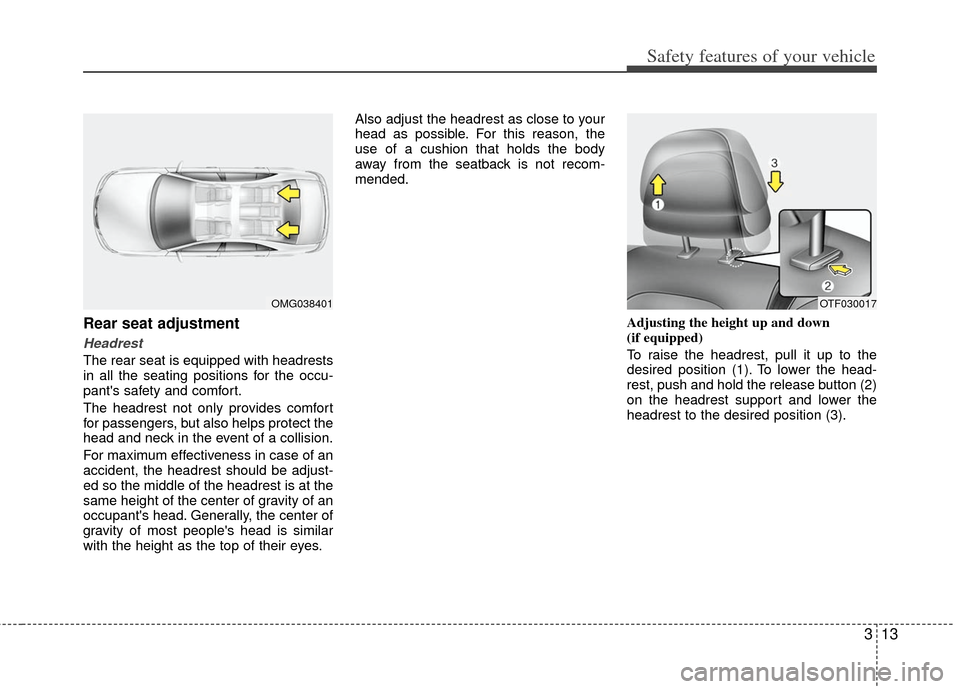
313
Safety features of your vehicle
Rear seat adjustment
Headrest
The rear seat is equipped with headrests
in all the seating positions for the occu-
pant's safety and comfort.
The headrest not only provides comfort
for passengers, but also helps protect the
head and neck in the event of a collision.
For maximum effectiveness in case of an
accident, the headrest should be adjust-
ed so the middle of the headrest is at the
same height of the center of gravity of an
occupant's head. Generally, the center of
gravity of most people's head is similar
with the height as the top of their eyes.Also adjust the headrest as close to your
head as possible. For this reason, the
use of a cushion that holds the body
away from the seatback is not recom-
mended.
Adjusting the height up and down
(if equipped)
To raise the headrest, pull it up to the
desired position (1). To lower the head-
rest, push and hold the release button (2)
on the headrest support and lower the
headrest to the desired position (3).
OMG038401OTF030017
Page 28 of 394
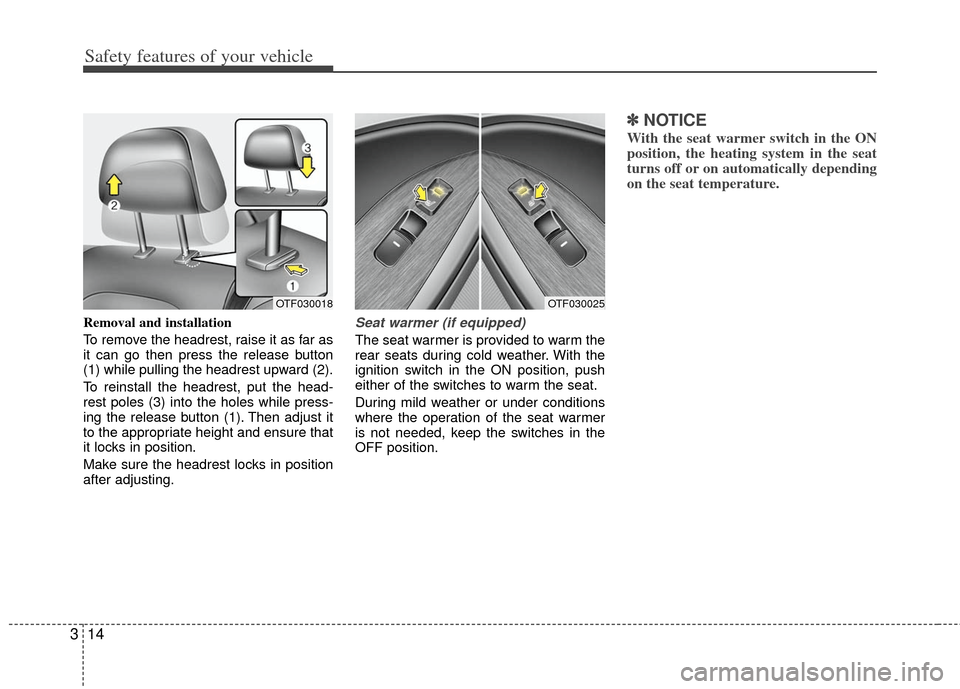
Safety features of your vehicle
14
3
Removal and installation
To remove the headrest, raise it as far as
it can go then press the release button
(1) while pulling the headrest upward (2).
To reinstall the headrest, put the head-
rest poles (3) into the holes while press-
ing the release button (1). Then adjust it
to the appropriate height and ensure that
it locks in position.
Make sure the headrest locks in position
after adjusting.Seat warmer (if equipped)
The seat warmer is provided to warm the
rear seats during cold weather. With the
ignition switch in the ON position, push
either of the switches to warm the seat.
During mild weather or under conditions
where the operation of the seat warmer
is not needed, keep the switches in the
OFF position.
✽ ✽
NOTICE
With the seat warmer switch in the ON
position, the heating system in the seat
turns off or on automatically depending
on the seat temperature.
OTF030018OTF030025
Page 29 of 394
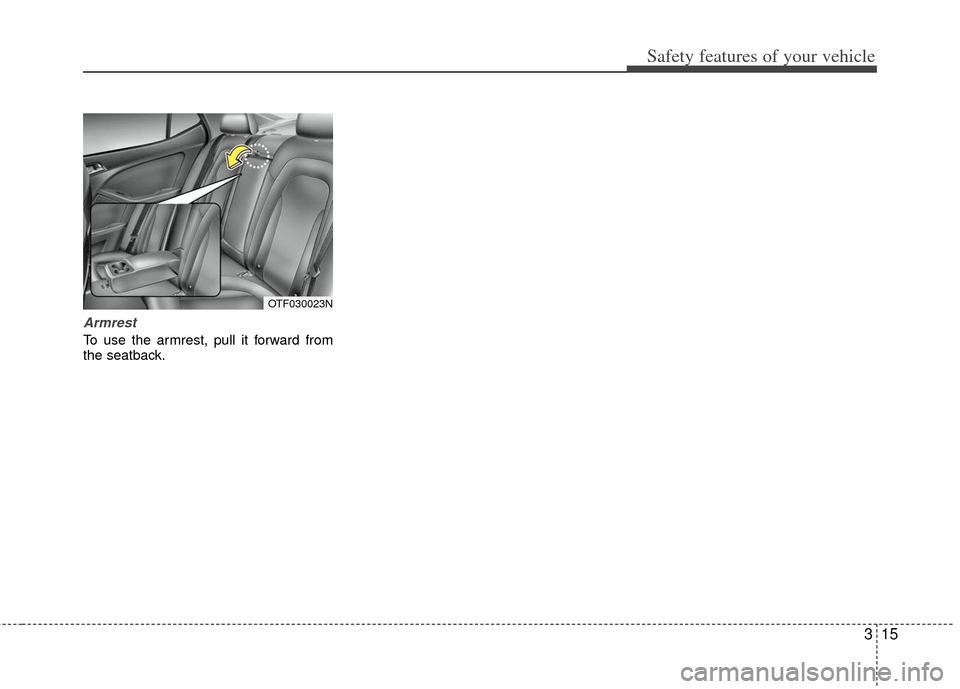
315
Safety features of your vehicle
Armrest
To use the armrest, pull it forward from
the seatback.
OTF030023N
Page 30 of 394
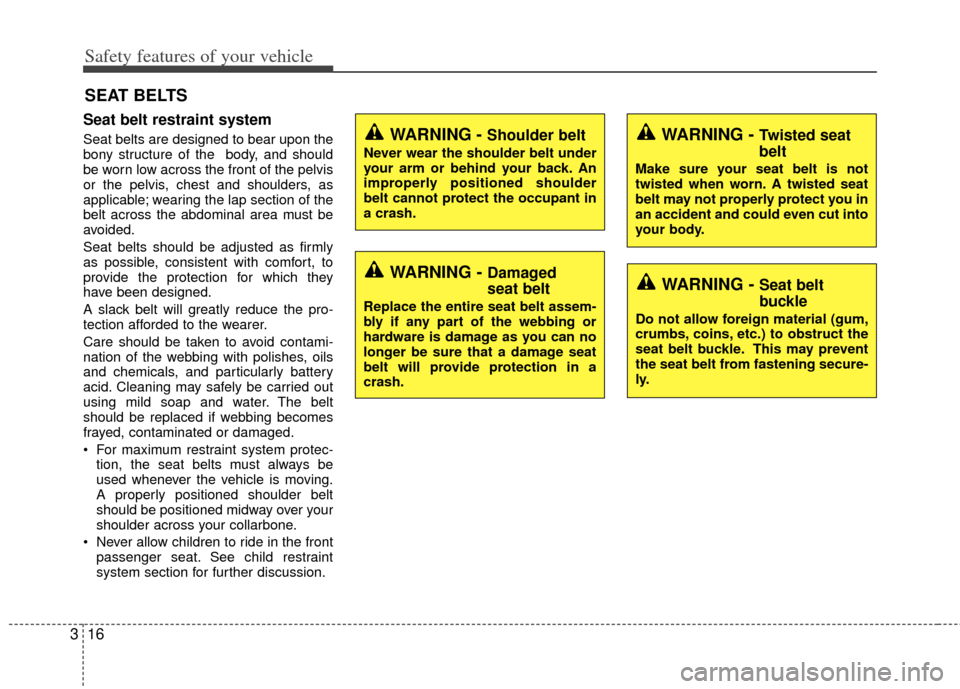
Safety features of your vehicle
16
3
Seat belt restraint system
Seat belts are designed to bear upon the
bony structure of the body, and should
be worn low across the front of the pelvis
or the pelvis, chest and shoulders, as
applicable; wearing the lap section of the
belt across the abdominal area must be
avoided.
Seat belts should be adjusted as firmly
as possible, consistent with comfort, to
provide the protection for which they
have been designed.
A slack belt will greatly reduce the pro-
tection afforded to the wearer.
Care should be taken to avoid contami-
nation of the webbing with polishes, oils
and chemicals, and particularly battery
acid. Cleaning may safely be carried out
using mild soap and water. The belt
should be replaced if webbing becomes
frayed, contaminated or damaged.
For maximum restraint system protec-
tion, the seat belts must always be
used whenever the vehicle is moving.
A properly positioned shoulder belt
should be positioned midway over your
shoulder across your collarbone.
Never allow children to ride in the front passenger seat. See child restraint
system section for further discussion.
SEAT BELTS
WARNING - Shoulder belt
Never wear the shoulder belt under
your arm or behind your back. An
improperly positioned shoulder
belt cannot protect the occupant in
a crash.
WARNING - Damaged
seat belt
Replace the entire seat belt assem-
bly if any part of the webbing or
hardware is damage as you can no
longer be sure that a damage seat
belt will provide protection in a
crash.
WARNING - Twisted seat
belt
Make sure your seat belt is not
twisted when worn. A twisted seat
belt may not properly protect you in
an accident and could even cut into
your body.
WARNING - Seat belt
buckle
Do not allow foreign material (gum,
crumbs, coins, etc.) to obstruct the
seat belt buckle. This may prevent
the seat belt from fastening secure-
ly.